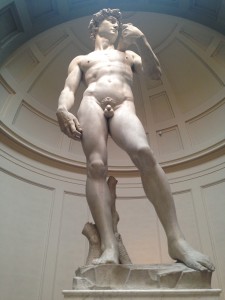To begin, I thought this particular reading was going to be very procedural, just a “how-to” guide on how to catalog, but it turned out to give much deeper insight into the meaning of art. One section I found particularly interesting was the section that asks you to describe what you are cataloging. This seems like it would be the most basic step but like Baca mentions, this could be incredibly complex. To define objects and to begin to catalog them means you have to understand exactly what they are and how they relate. However, this begins to get tricky when Baca gets to the section describing what is a work and what is an image. It begins to become entangled here because you are forced to make the distinction between what is a work depicted in a work (like the painting displayed below – an artistic visualization of Michelangelo’s David)

and what is just an image of a work – similar to the picture I took on my cell phone of David (as an example of something you might find commercially).

However, I believe that this really just depends on perception. Some photographs really could be considered works of art. I know that it isn’t my place to disagree, because this is all pretty technical, but I think that often times the photographs that Baca writes will “be treated as photographic documentation and recorded in an Image Record” could be considered by the photographer as an actual work of art. In the picture I took, it was just clearly meant to document what I was seeing so that I could bring it home and show it to my friends and family. However, often times the images people take of large architectural scenes or the Eiffel Tower have lovely photographic displays that shouldn’t just be accounted into an image record because they’re not from the 19th century.